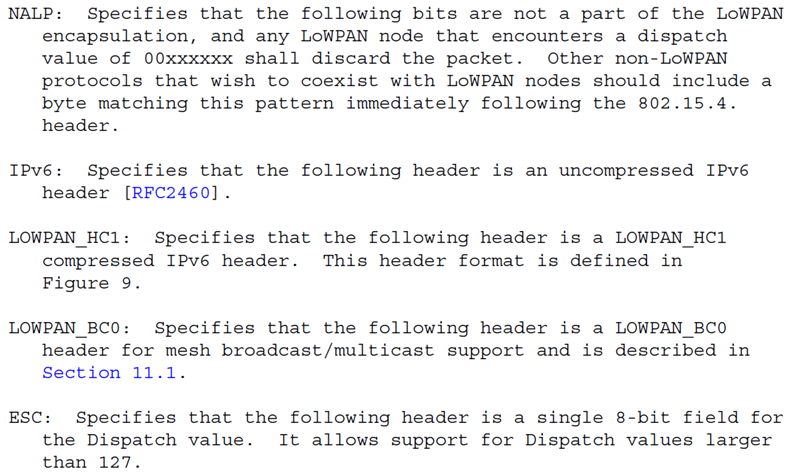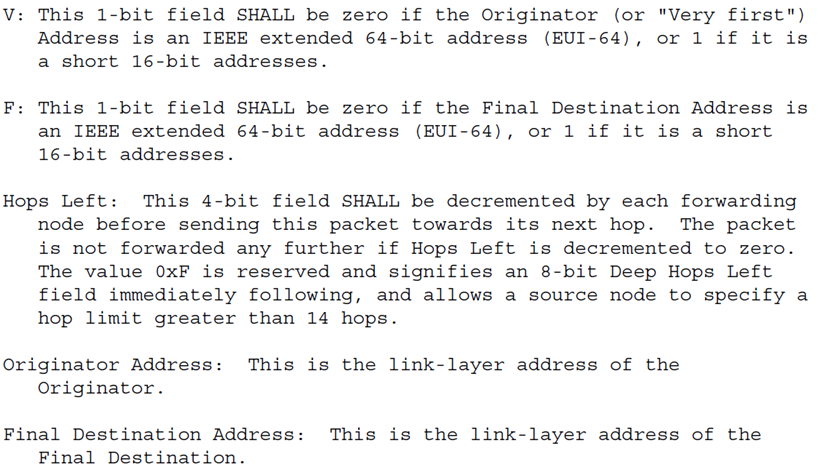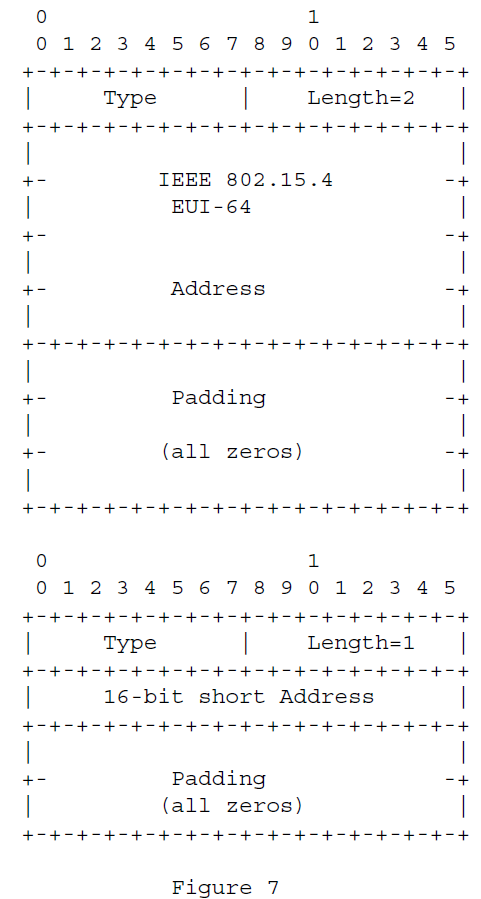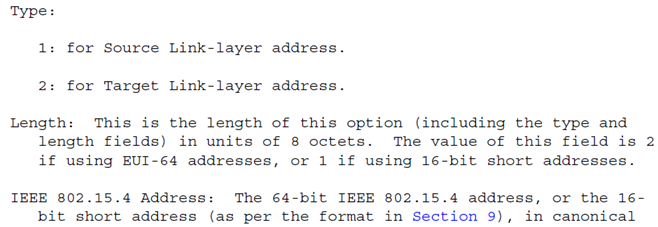6LoWPAN - Transmission of IPv6 Packets over IEEE 802.15.4 Networks
6LoWPAN covered topics include the following:
- Frame format for transmission of IPv6 packets
- Method of forming IPv6 link-local addresses
- Statelessly autoconfigured addresses on IEEE 802.15.4 networks
- Simple header compression scheme using shared context
- Provisions for packet delivery in IEEE 802.15.4 meshes
IEEE 802.15.4 Mode for IP
- IEEE 802.15.4 defines four types of frames: beacon frames, MAC command frames, acknowledgement frames, and data frames.
- IPv6 packets MUST be carried on data frames.
- IEEE 802.15.4 networks can either be nonbeacon-enabled or beaconenabled.
- 6LoWPAN does not require that IEEE networks run in beacon-enabled mode.
- Beacons are still useful for link-layer device discovery to aid in association and disassociation events.
- 6LoWPAN requires both source and destination addresses be included in the IEEE 802.15.4 frame header.
- The source or destination PAN ID fields may also be included.
Addressing Modes
- IEEE 802.15.4 defines several addressing modes: IEEE 64-bit extended addresses or 16-bit short addresses unique within the PAN.
- 6LoWPAN supports both 64-bit extended addresses, and 16-bit short addresses.
- 6LoWPAN assumes that a PAN maps to a specific IPv6 link.
- Multicast is not supported natively in IEEE 802.15.4.
- IPv6 level multicast packets MUST be carried as link-layer broadcast frames in IEEE 802.15.4 networks.
- Broadcast frames are only heeded by devices within the specific PAN of the link:
- A destination PAN identifier is included in the frame, and it MUST match the PAN ID of the link in question.
- A short destination address is included in the frame, and it MUST match the broadcast address (0xffff).
- Hosts learn IPv6 prefixes via router advertisements.
Maximum Transmission Unit
- IEEE 802.15.4 frame sizes:
- Maximum physical layer packet size of 127 octets (aMaxPHYPacketSize) –
- Maximum frame overhead of 25 (aMaxFrameOverhead) –
- Link-layer security overhead (21 octets in AES-CCM-128, 9 and 13 in AES-CCM-32 and AES-CCM-64)
- leaves only 81 octets for IPv6 -
- IPv6 header of 40 octets
- leaves only 41 octets for upper-layer protocols, like UDP
- UDP uses 8 octets in the header
- leaves only 33 octets for application data.
- fragmentation and reassembly layer will use even more octets.
- Fragmention and reassembly adaptation layer must be provided at the layer below IP.
LoWPAN Adaptation Layer and Frame Format
- All LoWPAN encapsulated datagrams transported over IEEE 802.15.4 are prefixed by an encapsulation header stack.
- LoWPAN header sequence is mesh (L2) addressing, hop-by-hop options (including L2 broadcast/multicast), fragmentation, and finally payload.


- When more than one LoWPAN header is used in the same packet, they MUST appear in the following order:
- Mesh Addressing Header
- Broadcast Header
- Fragmentation Header
Dispatch Type and Header

 、
、

Mesh Addressing Type and Header


Fragmentation Type and Header
- All link fragments for a datagram except the last one MUST be multiples of eight bytes in length.




Stateless Address Autoconfiguration
- All 802.15.4 devices have an IEEE EUI-64 address, but 16-bit short addresses are also possible.
- Interface Identifier is formed from the EUI-64 according to the "IPv6 over Ethernet" specification.
- When 16-bit short addressing is used, a "pseudo 48-bit address" is formed as follows:
- First, the left-most 32 bits are formed by concatenating 16 zero bits to the 16-bit PAN ID (or 16 zero bits) - 16_bit_PAN:16_zero_bits.
- Then, these 32 bits are concatenated with the 16-bit short address - 32_bits_as_specified_previously:16_bit_short_address.
- A different MAC address set manually or by software MAY be used to derive the Interface Identifier.
IPv6 Link Local Address

Unicast Address Mapping
- The Source/Target Link-layer Address option has the following forms when the link layer is IEEE 802.15.4 and the addresses are EUI-64 or 16-bit short addresses, respectively.


Multicast Address Mapping
- An IPv6 packet with a multicast destination address (DST), consisting of the sixteen octets DST[1] through DST[16], is transmitted to the following 802.15.4 16-bit multicast address:

Header Compression
Encoding of IPv6 Header Fields
- A packet is compressible via the LOWPAN_HC1 format by using a Dispatch value of LOWPAN_HC1 followed by a LOWPAN_HC1 header "HC1 encoding" field (8 bits) to encode the different combinations as shown below.
- This header may be preceded by a fragmentation header, which may be preceded by a mesh header.\




Encoding of UDP Header Fields


6LoWPAN - Transmission of IPv6 Packets over IEEE 802.15.4 Networks的更多相关文章
- 蓝牙(Bluetooth) IEEE 802.15.1 协议学习
catalogue . 蓝牙概念 . 配对和连接 . 机密安全性 . 蓝牙协议分类 . 蓝牙协议栈 1. 蓝牙概念 蓝牙(Bluetooth)是一种无线技术标准,可实现固定设备.移动设备和楼宇个人域网 ...
- IEEE 802.15介绍
1. 无线通信 无线通信主要是利用无线电(Radio)射频(RF)技术的通信方式,无线网络是采用无线通信技术实现的网络无线网络可为两种: 近距离无线网络和远距离无线网络 近距离无线网络主要可分为如下两 ...
- IEEE 802.15.4协议学习之物理层
在详细讲述IEEE 802.15.4协议之前,谈谈自己这两个星期看协议过程中的一点心得,或者是收获吧. 看协议文档,一定要看有书签的,边看边在旁边做些备注,以便于后期整理.对于协议层次相关的,最好在纸 ...
- IEEE 802.15.4协议学习之MAC层
MAC负责建立于网络的同步,支持关联和取消关联.MAC层的安全以及控制物理信道访问机制.信道访问机制主要有以下几种: 1. 有序的物理无线信道访问机制 2. 协调器启动和维 ...
- 计算机网络六:无线局域网、IEEE 802.11、WIFI和蓝牙
无线局域网.IEEE 802.11.WIFI和蓝牙 ㈠无线局域网 1.定义 无线局域网络(Wireless Local Area Networks),简称WLAN.它是相当便利的数据传输系 ...
- XBee 802.15.4/Digimesh FAQs:如何为2.4G模块选择合适的信道
XBee 802.15.4模块和XBee Digimesh模块在硬件上完全相同,只是出厂带有不同固件,如果测试需要,这两个固件可以都可以互换烧入模块中. 如何为2.4G模块选择合适的信道 IEEE 8 ...
- IEEE 802.3 Ethernet
Introduction Ethernet 是过去30年以来最为成功的局域网(local area networking)技术. 1. First widely used LAN technology ...
- IEEE 802.11p (WAVE,Wireless Access in the Vehicular Environment)
IEEE 802.11p(又称WAVE,Wireless Access in the Vehicular Environment)是一个由IEEE 802.11标准扩充的通讯协定.这个通讯协定主要用在 ...
- IEEE 802.11 标准列表
IEEE 802.11 标准列表 IEEE 802.11,1997年,原始标准(2Mbit/s,播在2.4GHz). IEEE 802.11a,1999年,物理层补充(54Mbit/s,播在5GHz) ...
随机推荐
- LM4990音频功放芯片
我们选用的一种封装:我们用的是DGK封装. 典型电路图: 下面是示意图:四中封装的示意图是不一样的: 下面是真正的原理图: 高放大倍数的原理图: 查分式的: 单个输入的原理图: 下面是有关电源的选择:
- loadrunne-- Analysis 分析器
本文转自:https://www.cnblogs.com/Chilam007/p/6445165.html Analysis简介 分析器就是对测试结果数据进行分析的组件,它是LR三大组件之一,保存着大 ...
- 驱动学习2-Menuconfig与Kconfig
Menuconfig: 执行make Menuconfig命令是为了产生.config文件 Kconfig: Kconfig中的指令可以改变Menuconfig图形界面中的东西,例如假如leds控制选 ...
- jvisualvm 工具使用
VisualVM 是Netbeans的profile子项目,已在JDK6.0 update 7 中自带(java启动时不需要特定参数,监控工具在bin/jvisualvm.exe). https:// ...
- 卫星网络中使用TCP协议的劣势(所以才有TCP优化版用来卫星通信啊,比如TCP-Peach和ADolar)
卫星网络中使用TCP协议的劣势 为了避免产生网络拥塞,原TCP协议综合采用了慢启动.拥塞避免.快速重传以及快速恢复等算法.但这些算法应用的前提是网络发生拥塞造成丢包,然而在误码率相对较高的卫星通信系统 ...
- php gettext方式实现UTF-8国际化多语言(i18n)
php gettext方式实现UTF-8国际化多语言(i18n) 一.总结 一句话总结: 二.php gettext方式实现UTF-8国际化多语言(i18n) 近 来随着i18n(国际化)的逐渐标准化 ...
- python opencv3 —— 常用工具、辅助函数、绘图函数(图像添加文本、矩形等几何形状)
1. cv2.hconcat().cv2.vconcat() 将从摄像头捕获的多个图像帧,横向(cv2.hconcat)或纵向(cv2.vconcat)拼接到一起,使得可以在一个 window 中进行 ...
- stm32的dma缓冲区长度,,存放数据数组会不会冲掉
- WPF应用程序启动的问题(自定义Main函数启动)
问题引入: 一般WPF创建之后可以直接运行并不需要编写Main函数指定入口,但是在开发的过程中会遇到一些情况需要自定义Main让WPF从指定的Main函数中进行启动,这样可能会更好控制一点.但是我们再 ...
- bootstrap+fileinput插件实现可预览上传照片功能
实际项目中运用: 功能:实现上传图片,更改上传图片,移除图片的功能 <!DOCTYPE html> <html> <head> <meta charset=& ...
